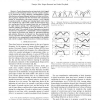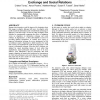21 search results - page 2 / 5 » Speed adaptation for a robot walking with a human |
106
click to vote
ICRA
2010
IEEE
14 years 11 months ago
2010
IEEE
— This paper presents the development of a biomechatronic knee prosthesis for transfemoral amputees. This kind of prostheses are considered ‘intelligent’ because they are abl...
105
click to vote
IROS
2006
IEEE
15 years 7 months ago
2006
IEEE
— Recently, many researchers on humanoid robotics are interested in Quasi-Passive-Dynamic Walking (Quasi-PDW) which is similar to human walking. It is desirable that control para...
AROBOTS
1999
15 years 28 days ago
1999
This paper outlines aspects of locomotor control in insects that may serve as the basis for the design of controllers for autonomous hexapod robots. Control of insect walking can b...
118
click to vote
ICRA
2007
IEEE
15 years 7 months ago
2007
IEEE
— Passive dynamics plays an important role in legged locomotion of the biological systems. The use of passive dynamics is expected for energy efficiency, self-stabilization agai...
HRI
2006
ACM
15 years 7 months ago
2006
ACM
Human-robot interaction could be improved by designing robots that engage in adaptive dialogue with users. An adaptive robot could estimate the information needs of individuals an...


